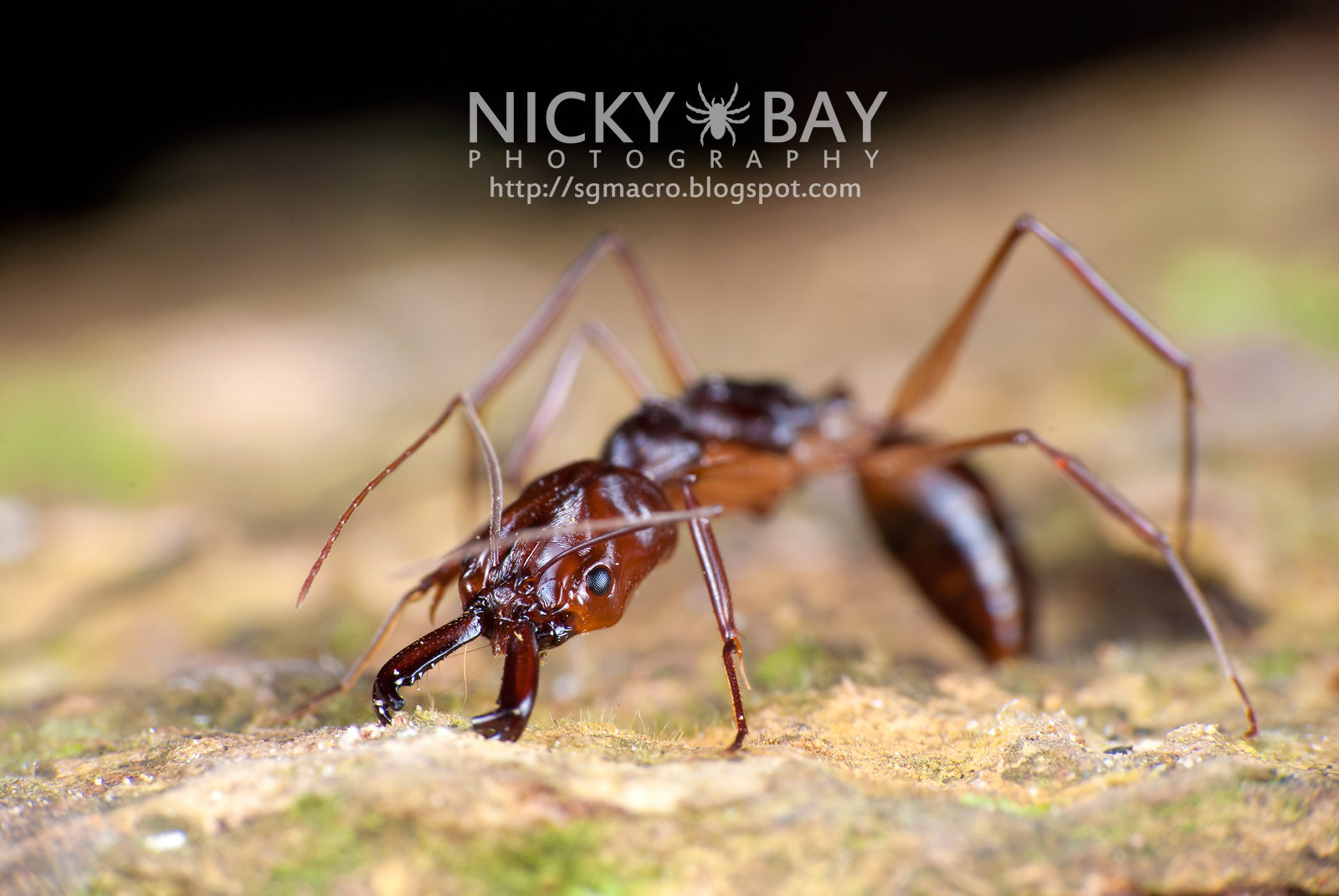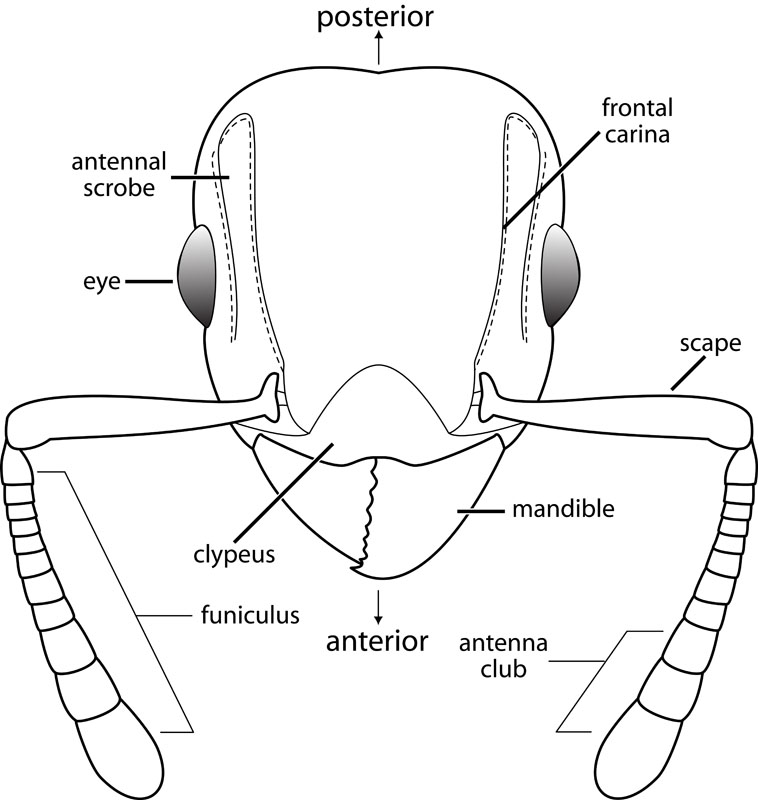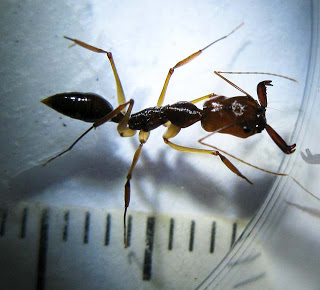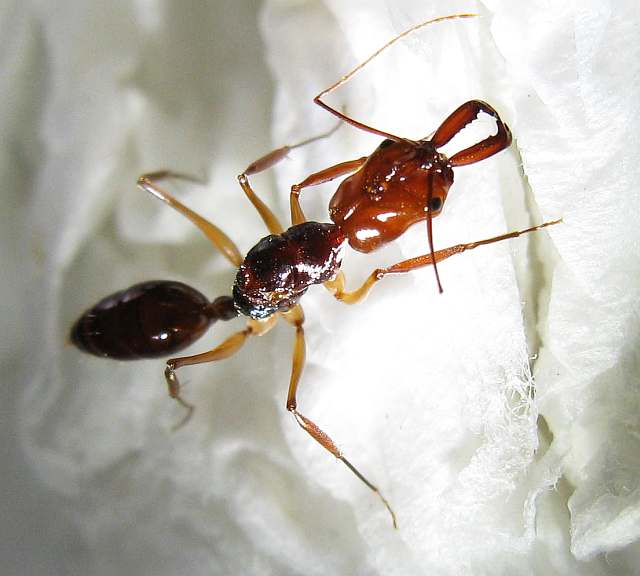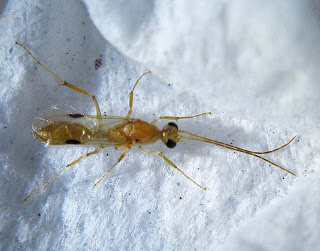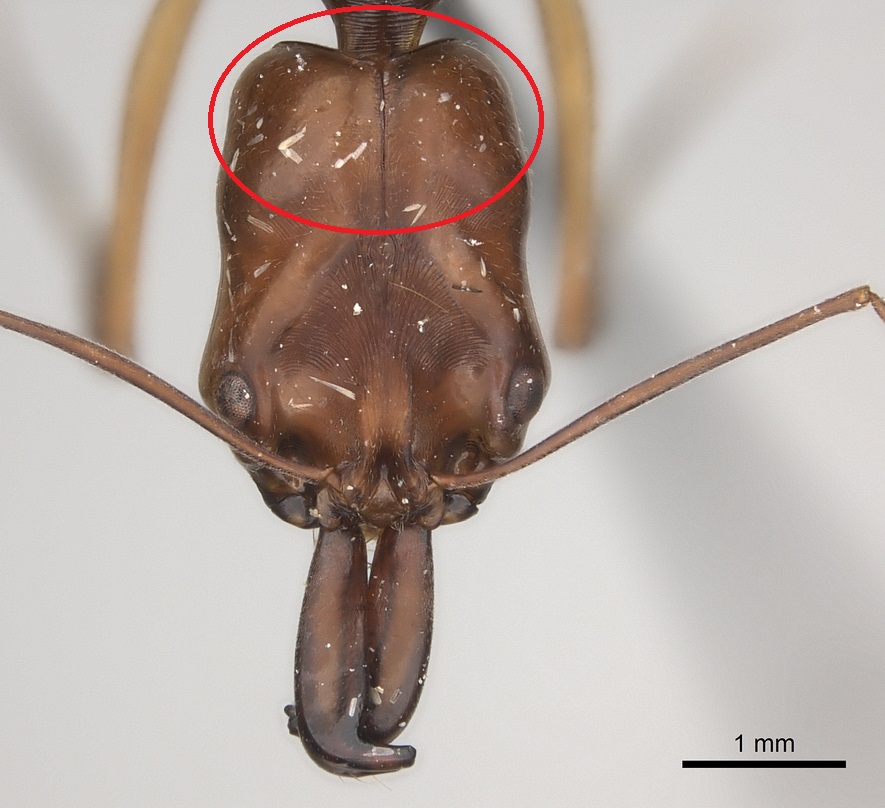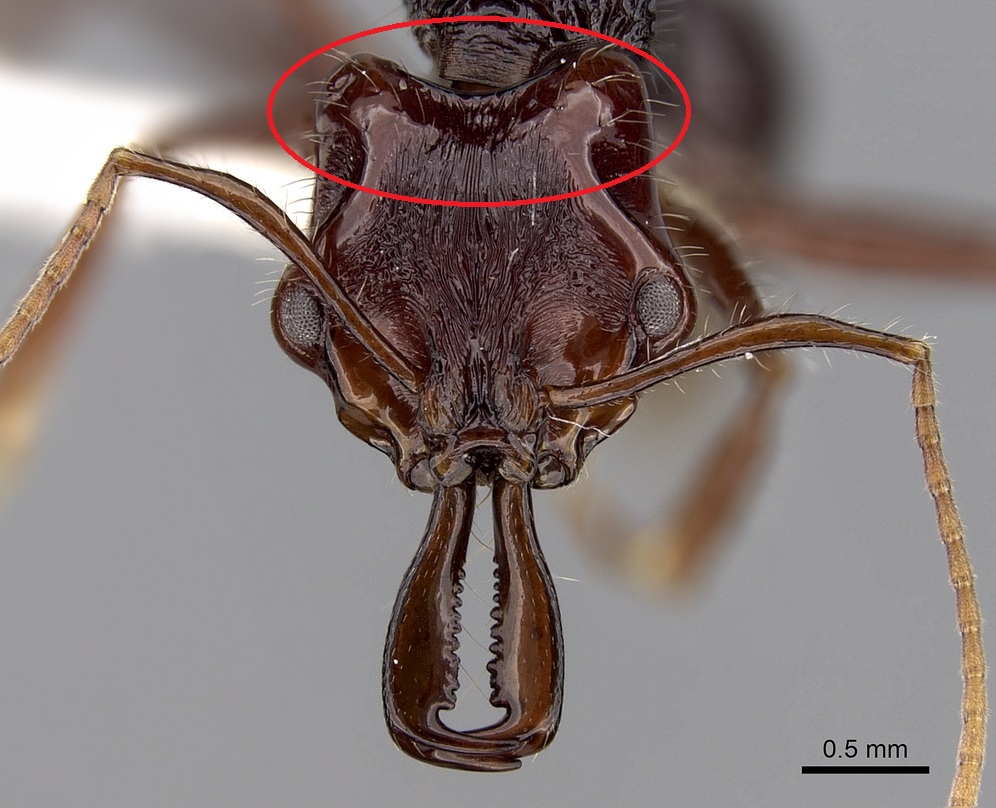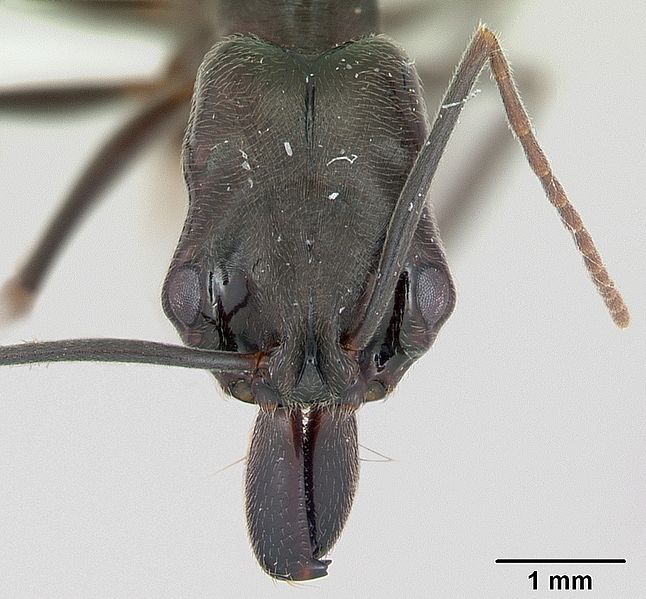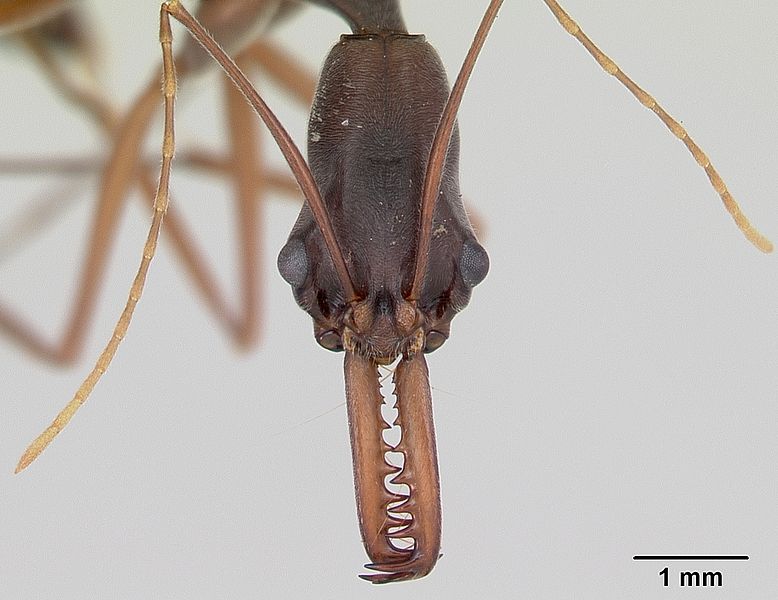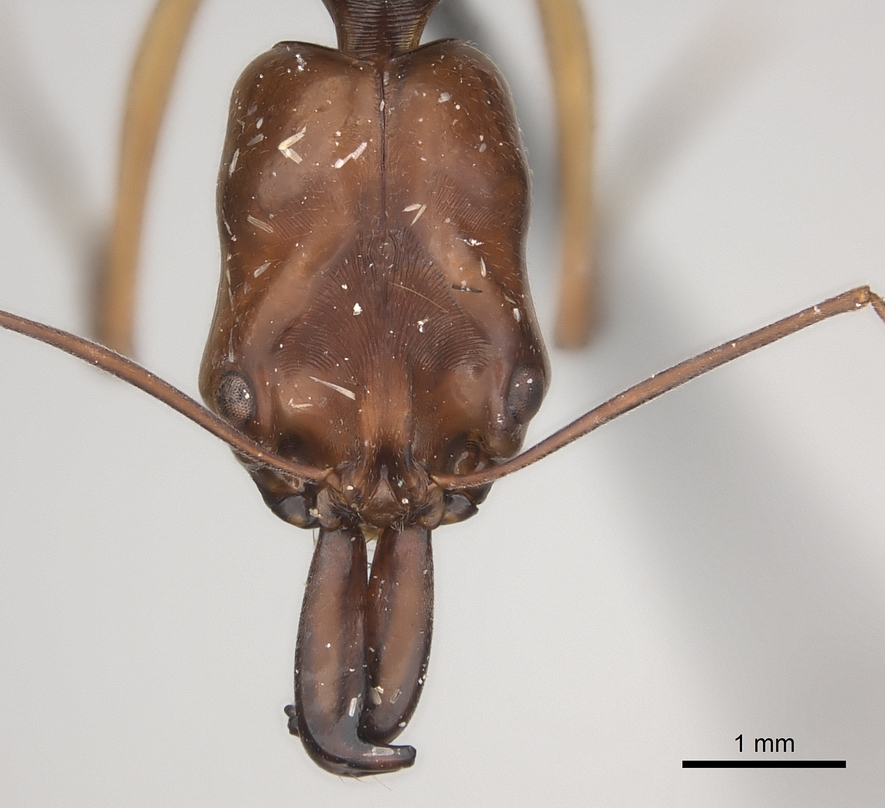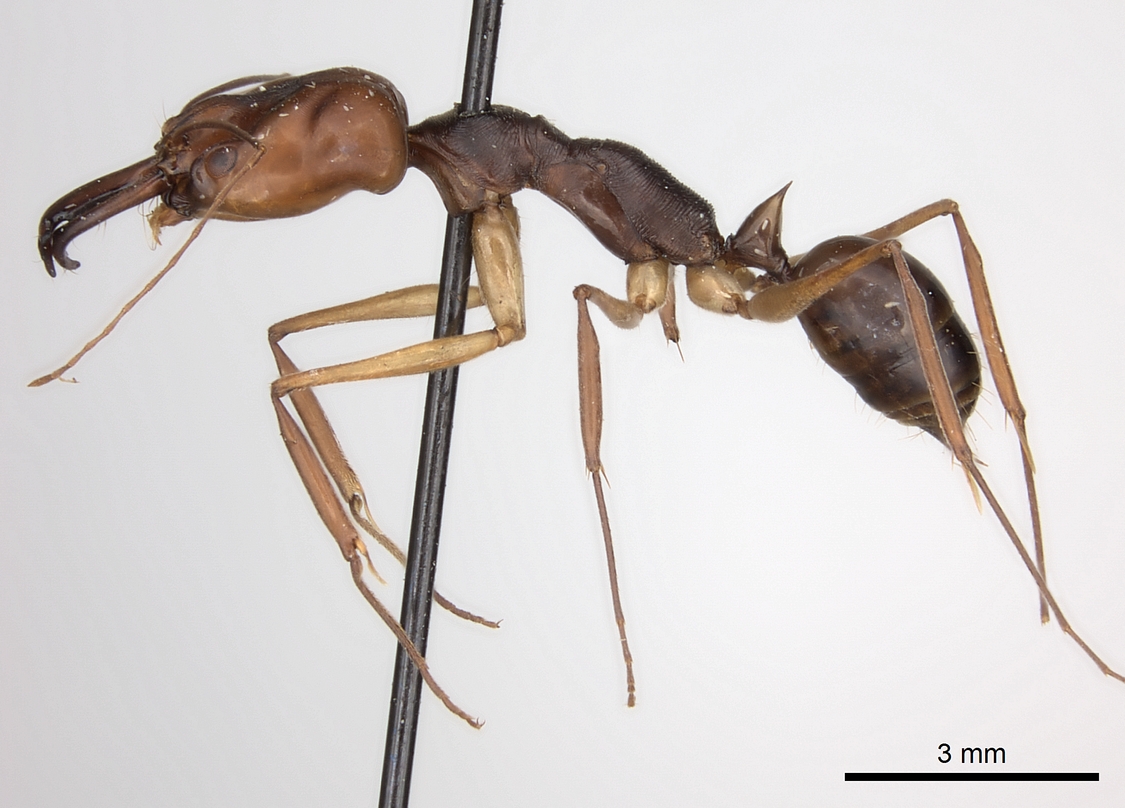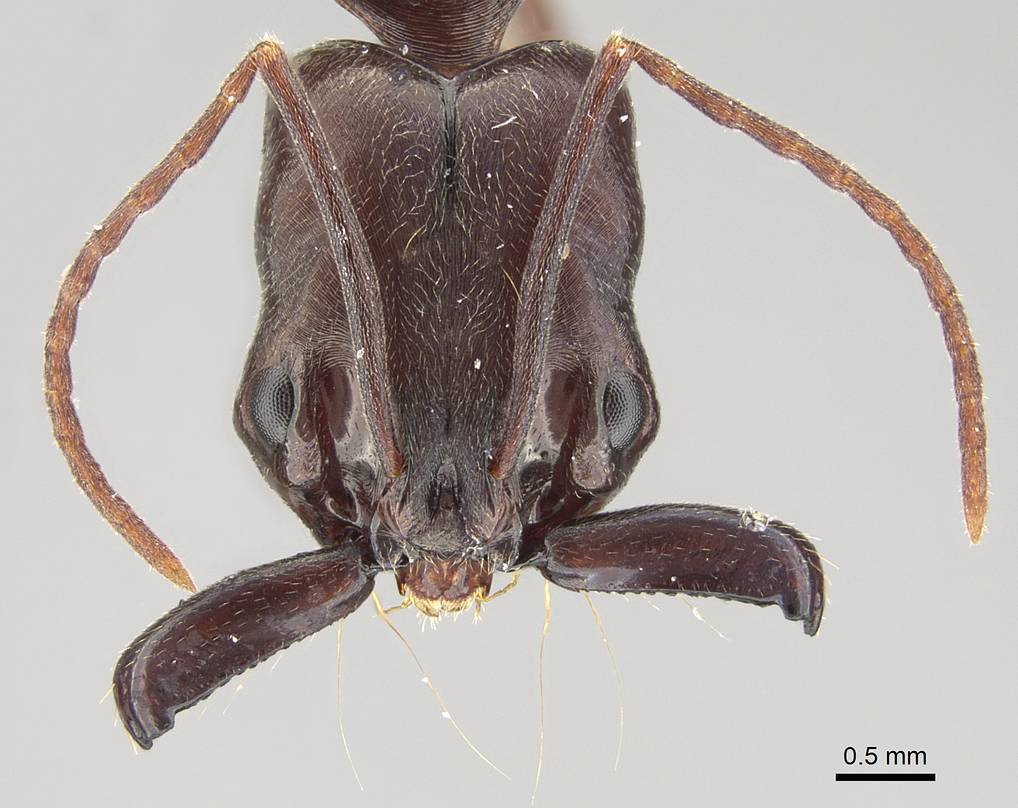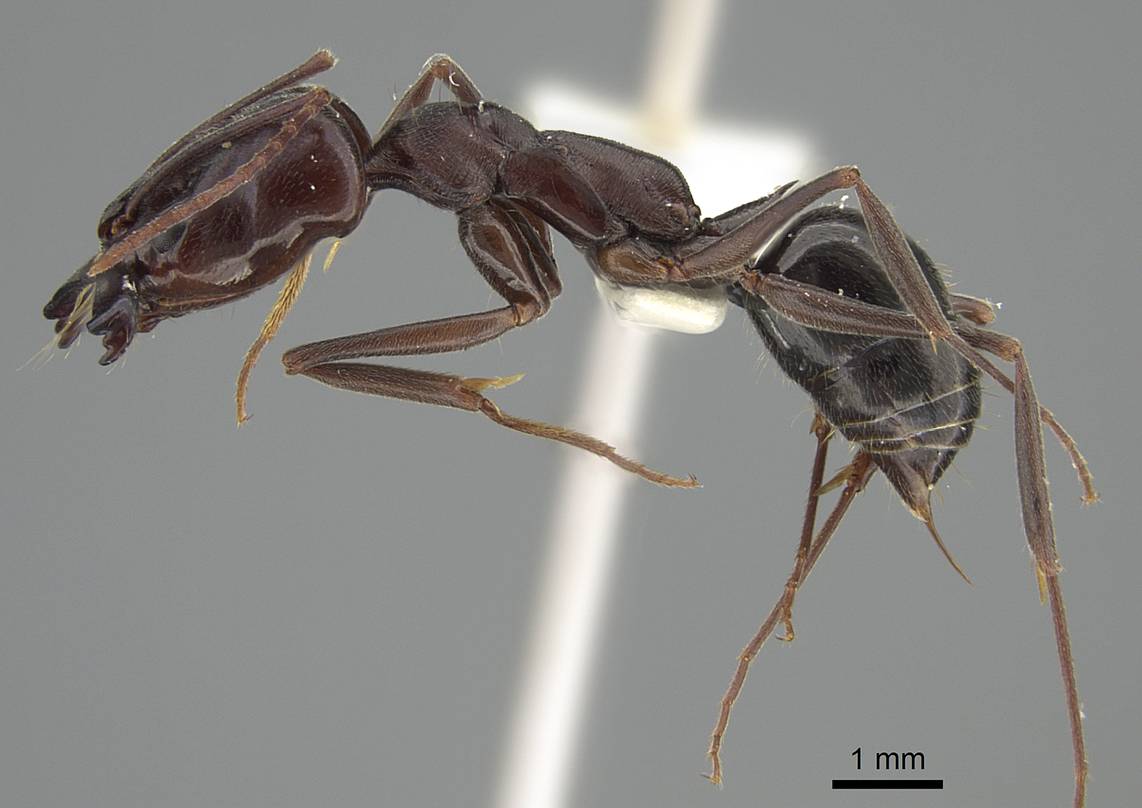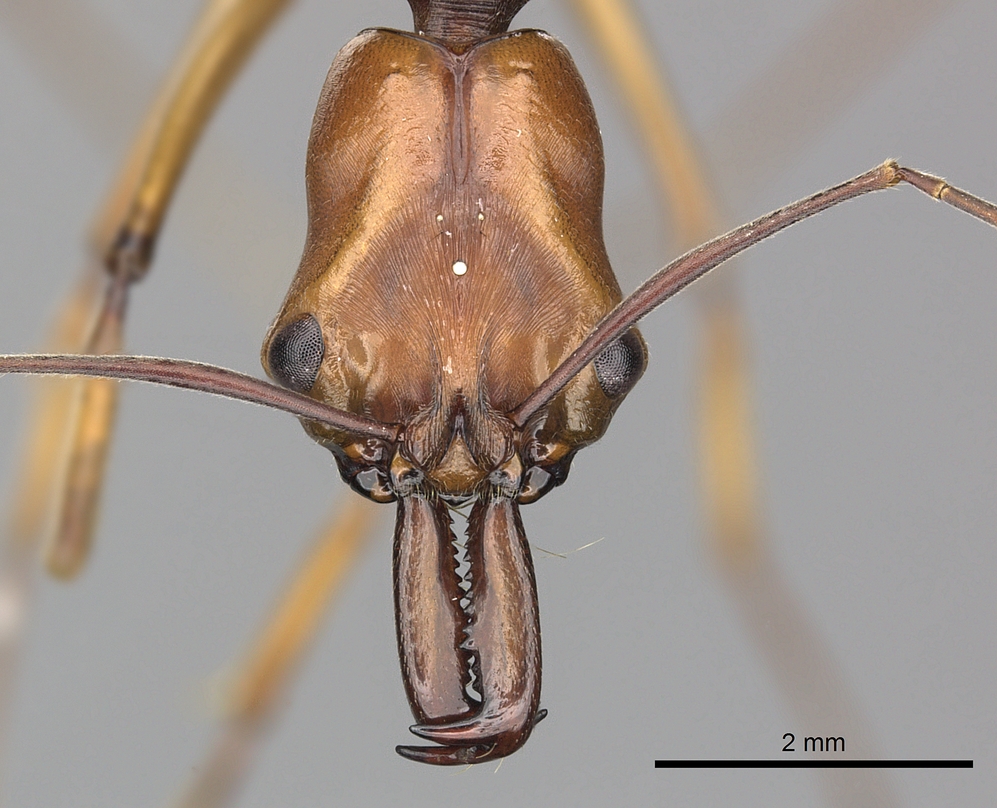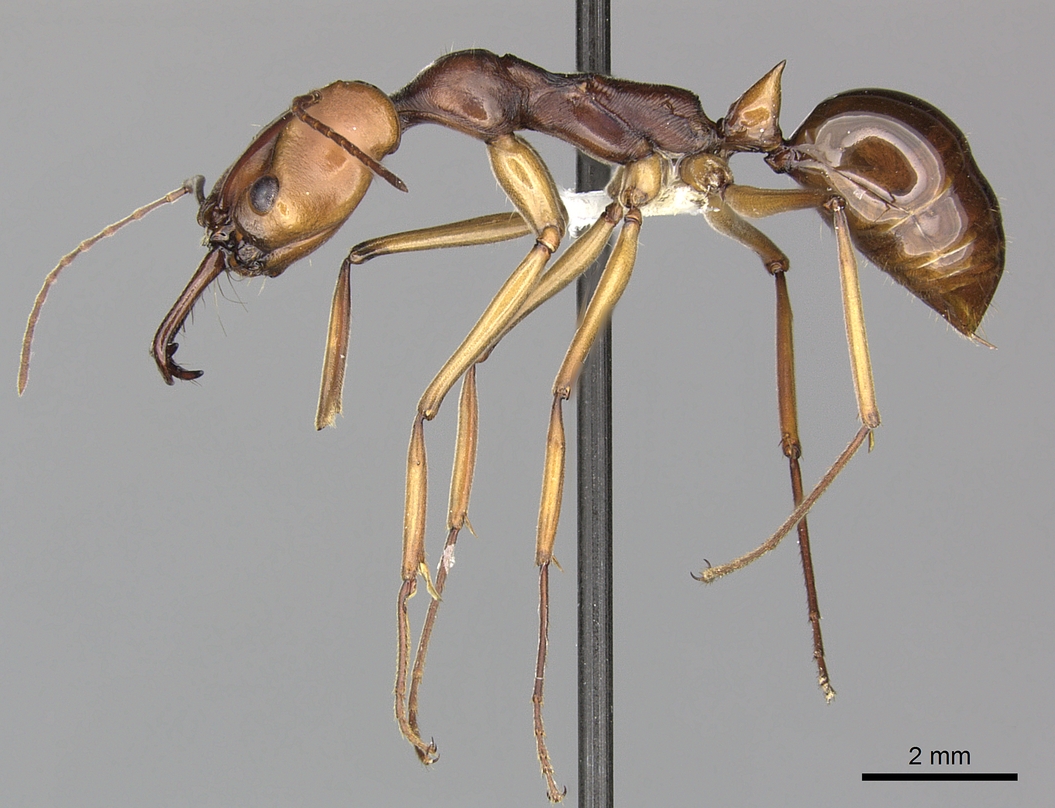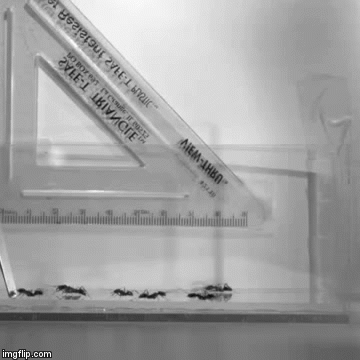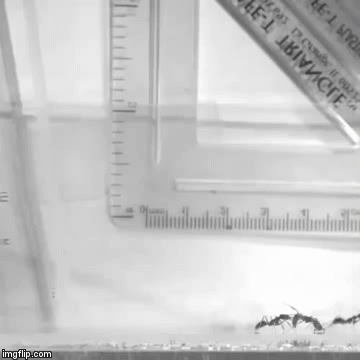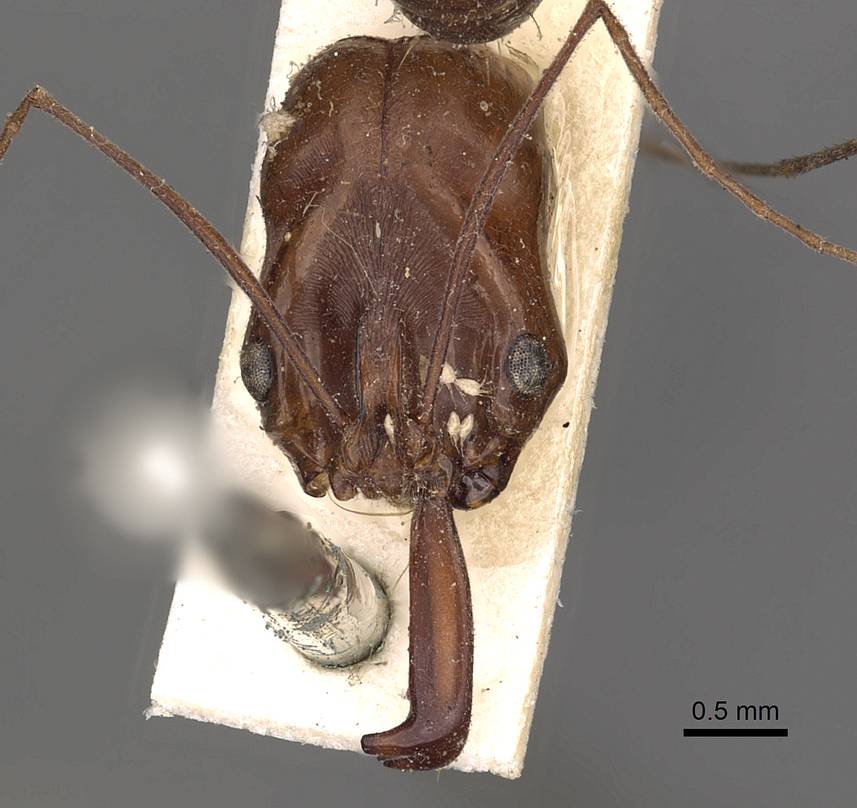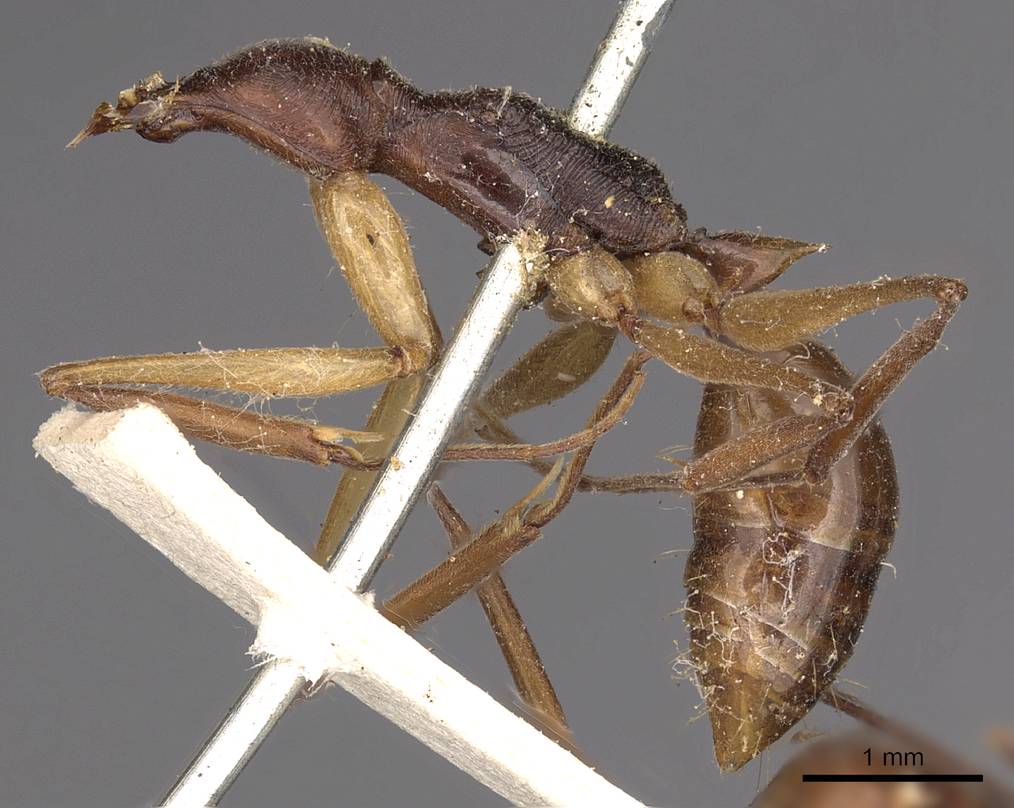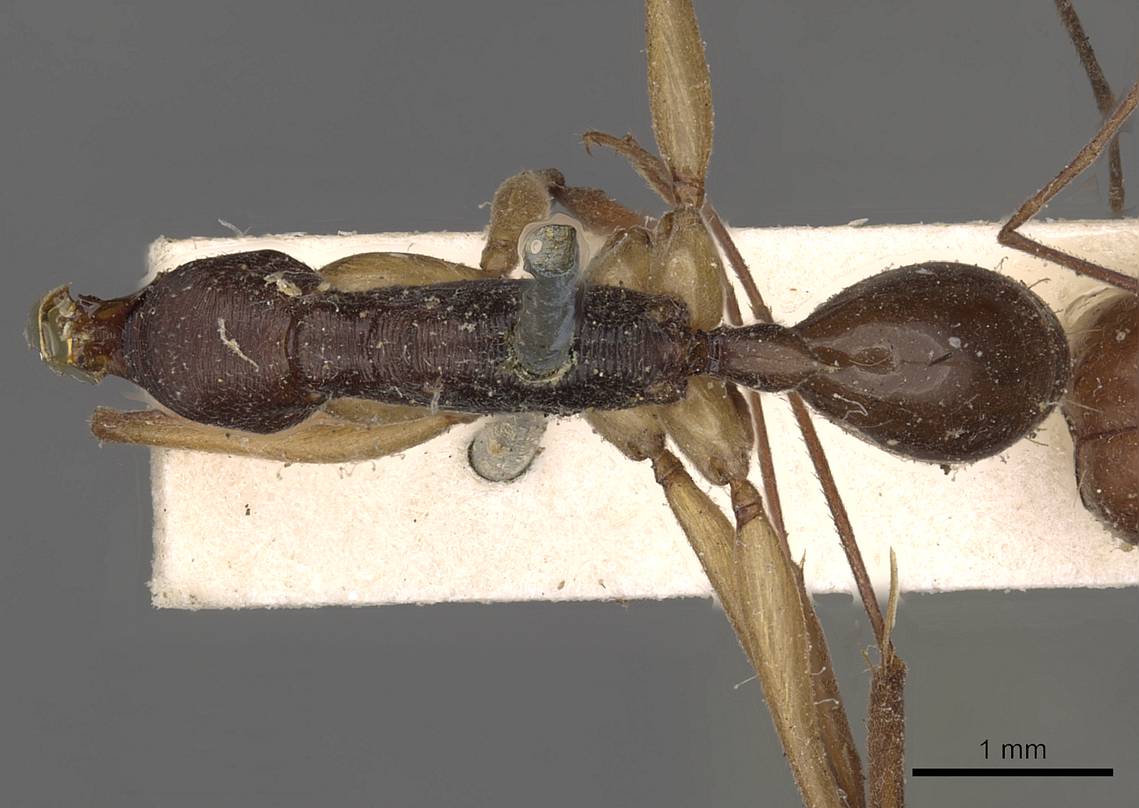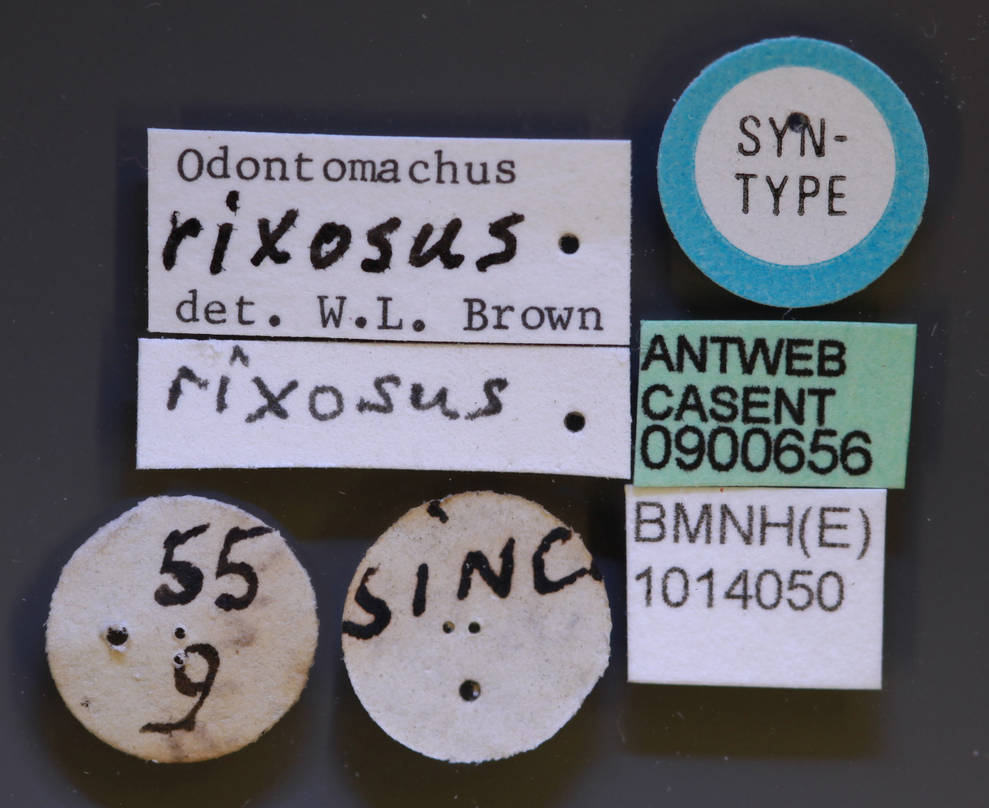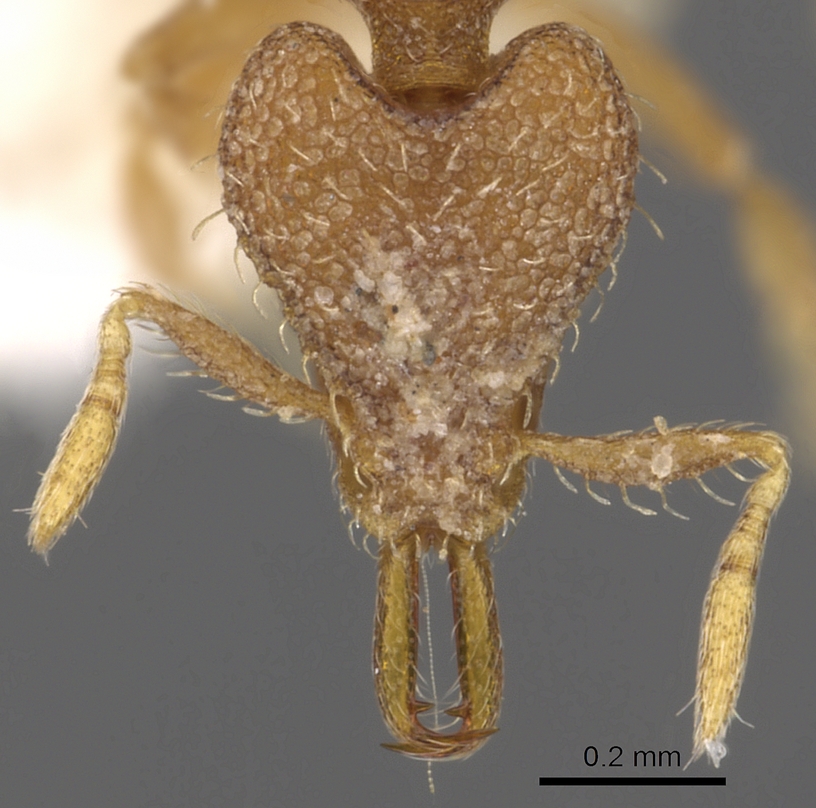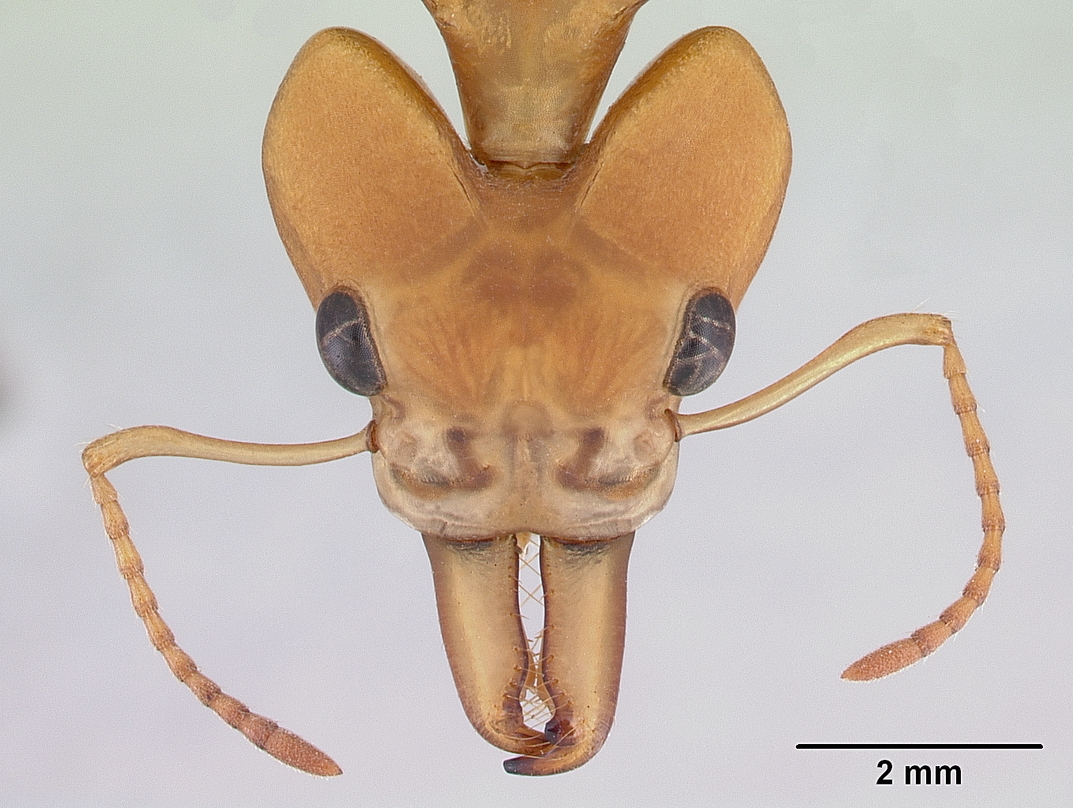1. It's a trap (-jaw ant)!
With their freakishly long and slender mandibles, these ants look like something straight out of a horror movie.
Odontomachus ants (commonly known as trap-jaw ants) are fearsome carnivores of the undergrowth [1]. Their powerful jaws are capable of closing at amazing speeds, trapping and killing prey, so much so that they have been described as “small alligators lost among the dimensions of the litter" [2] [3].
Trap-jaw ants can be commonly found in Singapore's forests and are easily recognised by their long mandibles which are cocked at 180° while foraging [11]. These ants use their strong head muscles to pull back their mandibles and locks them open with a mandible joint - sort of like putting a stick between the jaws of a crocodile [12]. The ant then walks around while using its antennae to detect prey, prepared to snap them shut the moment it comes into contact with a potential victim [11].
Trap-jaw ants are most diverse in the tropics, with a few species of Odontomachus occurring in Singapore [4]. One of these is Odontomachus rixosus (sometimes called the Asian trap-jaw ant) – a species first described with specimens collected from the forests of Singapore [5]!
Read on to learn more about this amazing (and scary-looking) species!
Some fun facts:
- Odontomachus translates to "fighting tooth" – an apt way to describe the jaws of these ants. For more on names, see the section on Names.
- The closing of jaws in Odontomachus ants is the fastest known movement in the animal kingdom – about 3 times faster than the previous record holder, the mantis shrimp's punch! Have a look at Behaviour to find out how it uses its jaws (and other weird things it can do)
- The slender trap-jaw mandibles in Odontomachus are not as unique as they seem, appearing in several other genera of ants as well. To see the evolutionary history of trap-jaws and more, have a look at the section on Phylogeny.
Note: Trap-jaw ants may refer to more than one group of ants. For the purpose of this page, the term "trap-jaw ant" refers to ants in the Odontomachus clade, unless stated otherwise.
2. Identifying Odontomachus rixosus
The descriptions in this section are not meant to be exhaustive. Rather, they serve as a quick guide to distinguishing one ant from the other. For more detailed descriptions for Odontomachus species, try looking at some of the keys at the end of this section!
2.1 Quick guide to distinguishing Odontomachus
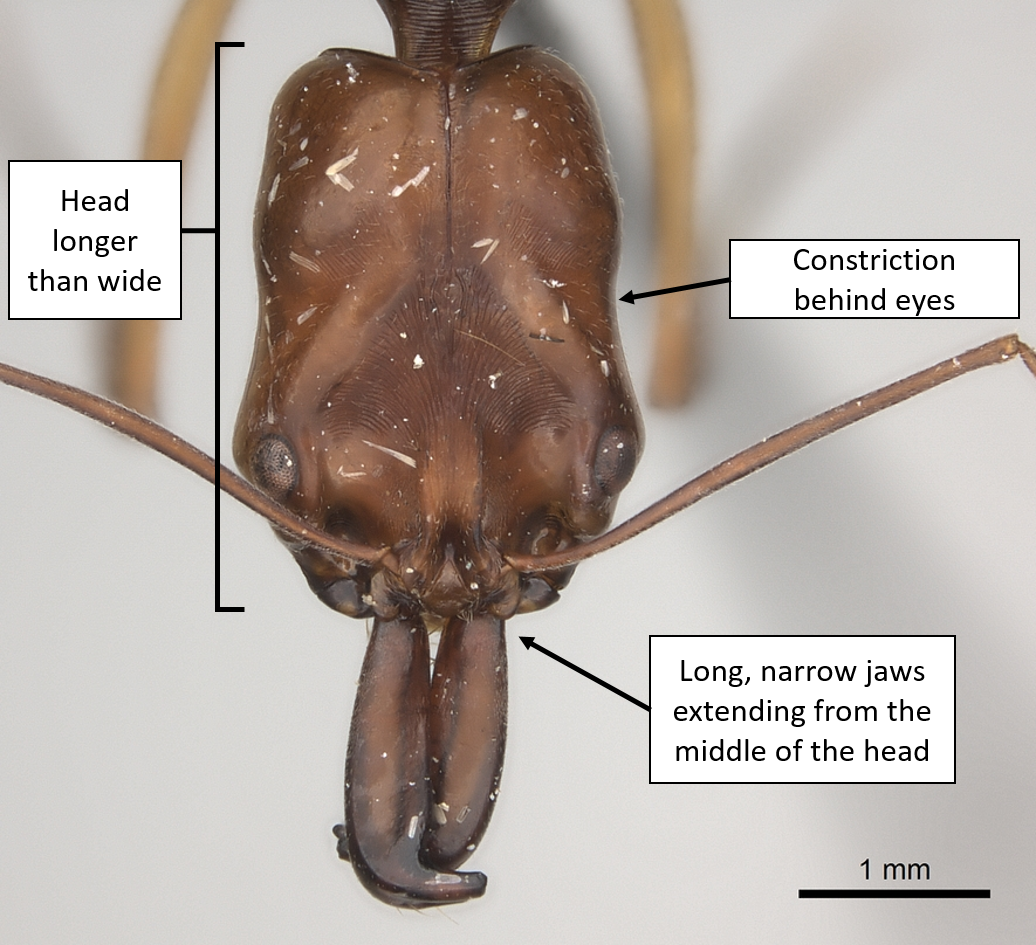 |
| Odontomachus rixosus. Photo by Will Ericson, taken from www.AntWeb.org. Creative Commons (CC BY 4.0) Annotations by Deon Lum. |
General distinction
Workers of Odontomachus are easily distinguished from most other ants by their straight, narrow mandibles which extend from the middle of their head as opposed to from the sides like in most other ants [6]. Their mandibles are capable of opening at 180° and have three large teeth at their tips with often a row of smaller teeth along the inside [6]. Their heads are also unlike those of typical ants, being wider than they are long and with a distinct constriction present behind their eyes (the head begins to curve inward after the eyes) [6].
The unique mandible and head shape is only present in the closely related Anochetus clade [6]. The next subsection will help in distinguishing between these two.
Queens are very similar to workers but slightly larger [6] [7]. They have small ocelli (simple eyes) present on the top of their heads [7]. They usually have a broader head and shorter mandibles than the workers of their species [7]. They also have a larger gaster and thorax [7].
Males have reduced mandibles, well-developed cerci, wings, and large ocelli on the top of their heads [7]. These characteristics, however, are also shared amongst most ponerine ants which makes it difficult to distinguish Odontomachus males from other ponerines [7]. That being said, one may be able to distinguish males by looking at the the petiolar node. In Odontomachus males, this is more or less conical – corresponding to the shape of the node in workers and queens – and may help to differentiate them from males of closely-related clades (of Anochetus, for example) [7].
|
|
|
Odontomachus versus Anochetus
While Odontomachus and Anochetus are very similar in head shape and mandibles, they are easily differentiated by the posterior surface of their heads [6]. In Odontomachus, the nuchal carina is V-shaped medially and the posterior of the head has a pair of dark converging lines [6]. In Anochetus, the nuchal carina is continuously curved and the posterior of the head lacks the converging lines [6].
|
|
Can you identify the Odontomachus species below? Click here to see the answer!
The first and third are Odontomachus ants while the middle is an Anochetus. From left to right: Odontomachus bauri, Anochetus armstrongi, Odontomachus coquereli.
O. bauri and A. armstrongi are easily distinguishable by the posterior of their heads. O. coquereli may look different but it still has the long mandibles extending from the middle of the head and the V-shaped ridge and dark lines on the back of its head.
|
|
|
2.2 Quick guide to identifying Odontomachus rixosus
Once you've determined that the ant you're looking at is an Odontomachus, narrowing it down to a species gets a little trickier as differences become more subtle. This section will simply serve as a quick guide to distinguish Odontomachus rixosus workers from other Odontomachus in Singapore. (If you require more information, or are trying to distinguish queens/males, try one of the keys in Section 2.3)General Characteristics
- Size: Odontomachus workers are relatively small (head length about 3mm, Weber length about 3-4mm) [8].
- Colour: Orange-brown body with darker mesosoma and gaster (i.e. the middle and posterior sections of the ant). Legs are yellowish brown to orange brown, with the coxae and femora paler [8].
- Mandibles: Subapical teeth of mandibles are slightly truncate and long [3].
|
|
Odontomachus rixosus versus Other Singaporean Odontomachus
At least two other Odontomachus have been reported in Singapore: Odontomachus simillius [9] and Odontomachus malignus [10]. Here are some simple features that will help tell them apart:
| Distinguishing features |
||||||
| Odontomachus simillimus is easily distinguished from Odontomachus rixosus by its dark colour [3]. Other than that, it's mandible has a short, truncate subapical tooth which is long and only slightly truncate in Odontomachus rixosus. [3] |
|
|
||||
| Odontomachus malignus can be morphologically distinguished from Odontomachus rixosus by the sharp apical and subapical teeth on its mandibles [3]. It's antennae are also relatively short [3]. Ecologically, this ant lives in inter-tidal zones, unlike Odontomachus rixosus which inhabits forests [3]. So if you see a trap-jaw ant in one of Singapore's mangroves, it is likely to be this ant. Otherwise, a reddish-brown trap-jaw ant is most likely Odontomachus rixosus. |
|
|
2.3 Keys to Odontomachus
For more detailed information on distinguishing your Odontomachus ant, try one of the keys below. For help with ant morphology, see here or have a look at this image .- Key to Odontomachus workers (Brown, 1976), hosted on AntBase
- Key to Odontomachus of Sumatra (Satria et al., 2015), hosted on AntWiki
- Key to Odontomachus of Philippines (Sorger & Zettel, 2011), hosted on AntWiki
3. Behaviour
Crazy jaws, crazy ant. Undoubtedly, the most interesting traits of this ant stem from what it actually does with its huge jaws.
3.1 Foraging
While foraging, an Odontomachus ant holds its mandibles wide open at 180° [11]. It does so by using the strong muscles packed in its head (which is the reason for their weird head shape) to pull back its mandibles and then locks them open with a part of its mandible joint [12]. The ant then walks with its mandibles cocked open and antennae outstretched to detect prey [11].Once its antennae contact a prey, the ant withdraws them and re-positions itself for attack [11]. The ant continues toward its prey, ready to strike. The moment one of the sensory hairs on the inside of its mandibles are triggered by the prey, the locking mechanism is released, causing the mandibles to swing in at such great force that it can kill its victim in a single blow [13].
It is thought that this trap-jaw mechanism allows these ants to catch fast-moving or chemically-defended prey more efficiently [14].
Members of Odontomachus can close their jaws at speeds of up to 60m/s – or 2300 times faster than you can blink [15] [16]! This movement generates forces over 300 times the ants' body weight and is the fastest known movement recorded in any animal (about 3 times faster than the previous record held by the mantis shrimp) [6] [15].
The large forces involved in jaw-closing do have the potential to damage the mandibles, especially if the ant misses its prey [27]. It is thought that to avoid this, the mandibles decelerate as they come together, reducing their impact on each other if they were to collide [27].
 |
| A foraging Odontomachus rixosus worker. Photo by Bernard Dupont. Creative Commons (CC BY-SA 2.0) |
3.2 Mandible-powered jumps
But this ant doesn't just use its jaws for catching prey. When faced with a large threat, these ants use their jaws in a very different way. Snapping their jaws shut with great force, trap-jaw ants can fling themselves up – and away from intruders [15].Trap-jaw ants show two different kinds of mandible-powered jumps: (i) bouncer defence jumps and (ii) escape jumps [15].
Bouncer defence jumps occur when trap-jaw ants strike their mandibles on an intruder or a hard, vertical structure [15]. The strike results in the ants catapulting themselves horizontally more so than vertically. In contrast to bouncer defence jumps, escape jumps occur when the ants attempt to avoid the intruder altogether. Striking their jaws against the ground instead, the ants fling themselves vertically upward more so than horizontally [15]. With these jumps, ants can fling themselves over 20cm horizontally or 8cm vertically [15].
Escape jumps have been shown to significantly help these ants survive encounters with certain predators (e.g. antlions) [17]. Videos of trap-jaw ants escaping from an antlion using mandible-powered jumps can be seen in the supporting information of this study .
|
|
3.3 Leg jumps
Aside from using their mandibles to launch themselves up in the air, Odontomachus rixosus can also use their legs to jump. While this may some more normal than jaw-powered catapulting, it actually isn't: leg jumping behaviour has only been documented in a few ant genera and very rarely observed [18]. In fact, Odontomachus rixosus is currently the only species of Odontomachus in which this behaviour has been recorded [18].As opposed to mandible-powered jumps, leg jumps are shorter, more precise, and forward-oriented [18]. It is uncertain what the function of leg jumping is but it has been suggested that they might help the ant escape predators or capture prey more easily [18].
The second half of the video below (starting at about 0:42) documents this unique behaviour.
4. Biology
4.1 Diet
Odontomachus rixosus, like most other trap-jaw ants, are predators which forage for other organisms on the forest floor [1]. They mainly consume arthropods but have been known to go for sweet substances as well [1] [19].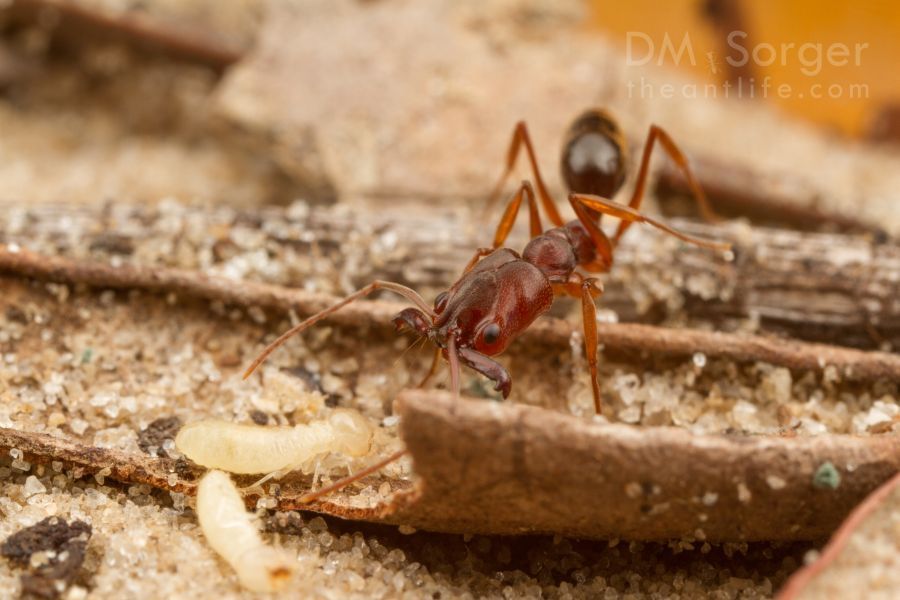 |
| Odontomachus relictus preying on a termite. Photo by D. Magdalena Sorger, taken from theantlife.com. Used with permission. |
4.2 Habitat
Odontomachus rixosus can be found in primary and secondary lowland forests as well as plantations [8]. The species nests under leaf litter near the base of living trees and under rotting wood [8]. Interestingly, the species has been found nesting together in compound colonies with Pheidole tandjongensis, although not much is known about this association [8].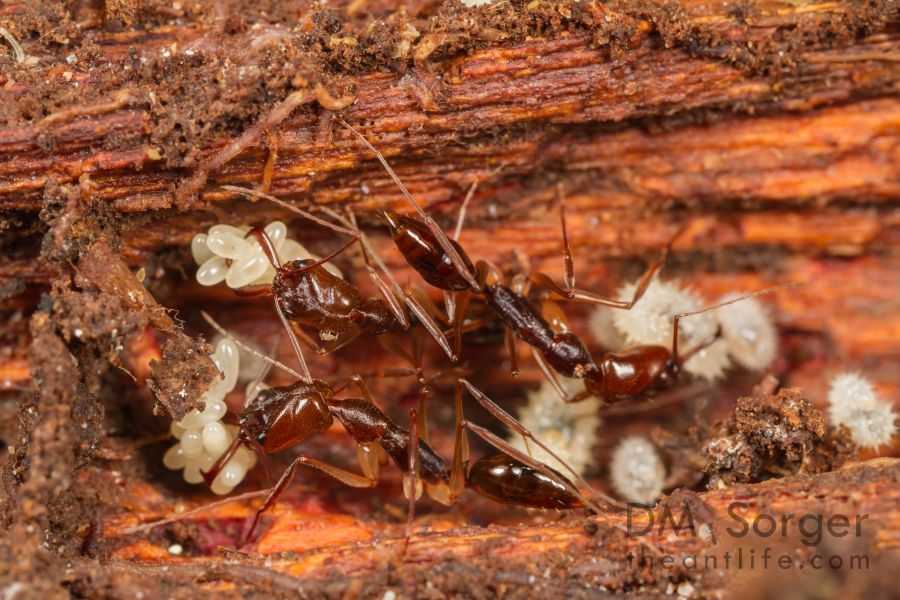 |
| Odontomachus rixosus nest. Photo by D. Magdalena Sorger, taken from theantlife.com. Used with permission. |
4.3 Colony composition
Odontomachus rixosus forms polygynous colonies i.e. colonies with multiple egg-laying queens [20]. On average, a colony has slightly over 20 queens and more than 100 workers, although colonies with more than 80 queens have also been observed [20].Queens within a colony vary in their level of ovarian development and behaviour, with the two being correlated [20]. Queens with less developed oocytes more frequently perform worker-like tasks such as foraging and larval care while those with more developed oocytes rest and care for eggs [20].
5. Distribution
5.1 Distribution of Odontomachus in general
Odontomachus ants can be found worldwide in tropical and warm temperate regions but are more diverse in the tropics [1] [4].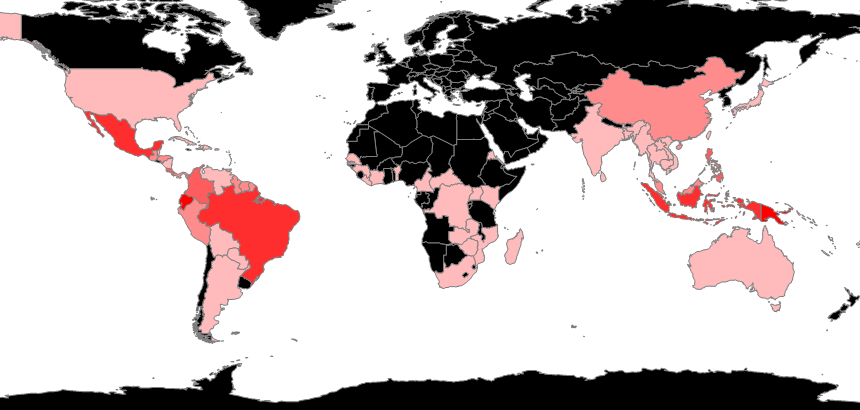 |
| Global distribution of Odontomachus species. Darker regions indicate higher species richness. Source: AntWiki. |
5.2 Distribution of Odontomachus rixosus
Our species of interest is commonly found in the forests of tropical south-east Asia [7] and has been documented in the following countries [21]:- Bangladesh
- Borneo
- Cambodia
- China
- India
- Indonesia
- Malaysia
- Myanmar
- Philippines
- Singapore
- Thailand
There appears to be no resources detailing the specific distribution of Odontomachus rixosus in Singapore. However, given that the species inhabits forests, it is likely that they can be found in some of our parks and reserves.
For an interactive distribution map of Odontomachus rixosus, have a look at AntMaps here .
6. Taxonomy and Systematics
6.1 Names
EtymologyThe genus name, Odontomachus, translates from Greek to "fighting tooth". If that wasn't enough, rixosus translates from Latin to "quarrelsome".
- Odont/dent = tooth (Gk)
- Machus = fight (Gk)
- rixosus = quarrelsome (Ln)
There appears to be no evidence to support the quarrelsome nature of the ant but if names are anything to go by, Odontomachus rixosus seems like a rather short-tempered ant with the tools to back it up.
Synonyms
Other than Odontomachus rixosus, there are two other valid synonyms for the species, both conferred by Forel [21]:
Odontomachus rixosus obscurior Forel, 1900
Odontomachus rixosus conifera Forel, 1913
The individuals described by Forel vary slightly in colour but are thought to be taxonomically insignificant [3]. As such, both these names are currently considered junior synonyms of Odontomachus rixosus.
No taxonomic revisions have been made to the species since its description by Smith in 1857 and thus it retains its original name. That being said, there could be future revisions as it appears that Odontomachus rixosus may be split into several species (Sorger, DM, personal communication, November 8, 2016).
6.2 Taxonavigation
Classification of Odontomachus rixosus above the species level (and below Insecta) is as follows [22]:| Class |
Insecta |
| Subclass |
Pterygota |
| Infraclass |
Neoptera |
| Order |
Hymenoptera |
| Suborder |
Apocrita |
| Infraorder |
Aculeata |
| Superfamily |
Vespoidea |
| Family |
Formicidae |
| Subfamily |
Ponerinae |
| Tribe |
Ponerini |
| Genus |
Odontomachus |
6.3 Type specimens
SyntypesA syntype worker of Odontomachus rixosus is currently held in the British Museum of Natural History [21]. The specimen was originally collected from Singapore by A. R. Wallace and then used by F. Smith to describe the species in 1857 [5]. Syntypes of Odontomachus rixosus conifera and Odontomachus rixosus obscurior (which are currently thought to be taxonomically insignificant[3]) are both held in the Natural History Museum of Geneva [21].
Odontomachus rixosus syntype
Specimen ID: CASENT0900656
Collected from Singapore
Current location: British Museum of Natural History
Odontomachus rixosus conifera syntype
Specimen ID: CASENT0907432
Collected from Indonesia, Java
Current location: Natural History Museum of Geneva
Odontomachus rixosus obscurior syntype
Specimen ID: CASENT0907431
Collected from Myanmar
Current location: Natural History Museum of Geneva
For more information on these syntypes, click the specimen ID.
Photos of the Odontomachus rixosus syntype
|
|
||||
|
|
6.4 Original description
Original description of an Odontomachus rixosus worker by Frederick Smith in 1857:“Worker. Length 4½ lines. Reddish-brown: the coxae, trochanters and femora pale testaceous, the extreme base, and apex of the latter, darker; the mandibles with two blunt teeth at their apex, the outer tooth notched on one side, forming a second tooth; the inner edge slightly serrated, having only four or five minute teeth; the prominence between the sulcations on the anterior part of the head, obliquely striated; the striations crossing the sulcations, but terminating opposite the hinder margin of the eyes; the depression on the sides of the head striated, the striation becoming obsolete at the sides of the head. The thorax transversely striated, the metathorax most strongly so. The scale of the abdomen conical, terminating above in an acute spine; the abdomen very smooth and shining, the apex pale testaceous."
6.5 Phylogeny
Relationships within antsAn analysis by Moreau et al. (2006) strongly supported a monophyly for ants (Hymenoptera: Formicidae) and divided the ants into three main clades: leptanilloid, poneroid and formicoid. Odontomachus was nested within the Ponerine clade [23]. There was strong support (100%) for all three clades based on Bayesian posterior probability. However, the Poneroid clade only had 64% support for maximum likelihood bootstrap and less than 50% for maximum parsimony bootstrap, suggesting that the clade might not be a monophyly. The Ponerinae clade (which Odontomachus is in) also received 100% support based on Bayesian posterior probability but only 77% support for maximum likelihood bootstrap and less than 50% for maximum parsimony bootstrap, again suggesting that the clade might not be monophyletic.
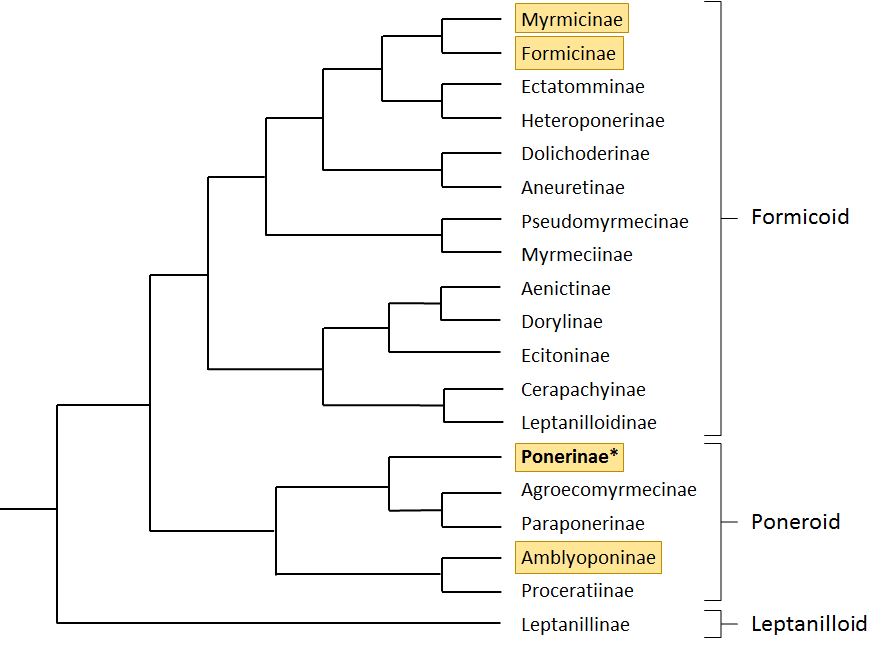 |
| Simplified tree adapted from Moreau et al. (2006). Analysis was done for 139 extant genera based on 4.5kb of sequence data extracted from six gene regions - 5 nuclear genes and 1 mitochondrial gene. Names of clades in yellow boxes indicate the presence of trap-jawed ants within that clade. Ponerinae (bold and asterisk) includes Odontomachus. Branch lengths do not convey any meaning in this diagram. |
The evolution of trap-jaws
While the information above may all seem very technical, the result we get from the analysis actually tells a pretty interesting story about the evolution of trap-jaws in ants. Trap-jawed ants occur in the clades Myrmicinae, Formicinae, Ponerinae (which consists of our Odontomachus ants), and Amblyoponinae [12]. If you observe the tree above, these clades are scattered all over the tree, suggesting that trap-jaws have evolved independently at least 4 times in ants! (The less likely alternative being that trap-jaws are an ancestral trait that all other ants have lost).
In fact, there is morphological evidence for such a hypothesis: the mechanism of trap-jaws differs between trap-jawed ants from different clades. For example, as mentioned earlier, Odontomachus use their mandible joint to trigger their jaw strikes but ants of Strumigenys and Daceton (both in Myrmicinae) use their labrum instead [24]. This slight difference in the origin of the trap-jaw mechanism in different clades suggests convergent evolution, with ants of different clades developing trap-jaws independently of each other.
This information does have to be taken with care though, as more detailed phylogenetic analysis (using more rigorous methods and other gene regions) may reveal different relationships – especially since there was low maximum likelihood and parsimony bootstrap support for the Poneroid and Ponerinae clades.
|
|
Within Odontomachus
The monophyly of Odontomachus was strongly supported by Schmidt (2013) [25]. Relationships within the group are generally poorly resolved, possibly due to rapid basal radiation [6].
A recent study by Larabee et al. (2016) also strongly supported Odontomachus as a monophyly (Bayesian posterior probability=1 and maximum likelihood bootstrap support ≥ 99), containing three clades which generally correspond to the biogeography of their consisting species: (A) species from Afrotropics and Southeast Asia (B) species almost entirely found in Central and South America (C) species in Australasia [26]. Odontomachus rixosus was found to be in clade A along with 5 other species from Madagascar, Africa and continental Asia [26].
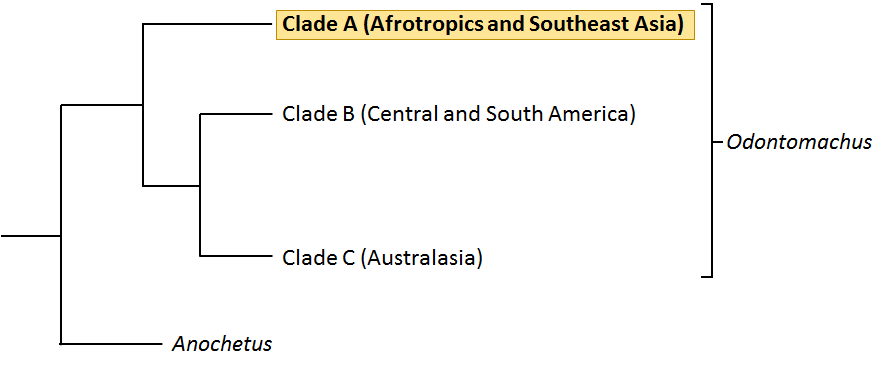 |
| Simplified tree showing the relationships between the 3 clades of Odontomachus. Odontomachus rixosus is in clade A. Adapted from Larabee et al. (2016). Species-level analysis of ants in Odontomachus and Anochetus was conducted based on one mitochondrial, one ribosomal RNA, and three nuclear protein-coding genes. Nodes shown here had support of BPP=1 and ML BS≥ 90. Anochetus not represented here. Branch lengths do not convey any meaning in this diagram. |
The relationships of the species within clade A are shown below. All nodes within the clade had support of BPP=1 and ML BS≥ 90, suggesting strong support for such a relationship between the species in this clade. All species within this clade show significant morphological variation (if you recall, Odontomachus coquereli from section 2.1 looks very different from Odontomachus rixosus) [26].
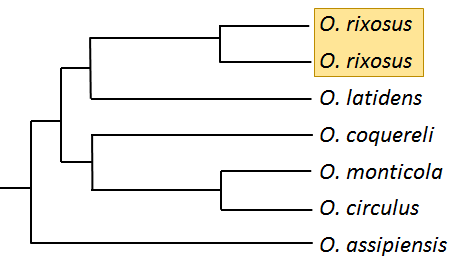 |
| Simplified tree showing the relationships between species of clade A. Adapted from Larabee et al. (2016). Nodes shown here had support of BPP=1 and ML BS≥ 90. Branch lengths do not convey any meaning in this diagram. Odontomachus rixosus appears twice in the tree because two specimens were used in the analysis (CASENT 0763851 and USNMENT 01124394). |
The phylogenetic analysis has also shed light on the relationships of species groups previously defined by morphological characteristics (see Brown 1976). It found that out of 21 species groups in Odontomachus and Anochetus, only 10 were monophyletic – showing the issues of defining relationships via morphology [26].
Interest in phylogenetics of Odontomachus (and trap-jawed ants in general) appears to be growing in recent years and it is likely that we will see more studies on these ants in the near future.
7. References
[1] Brown, W. L. J. (2000). Diversity of Ants In Agosti, D., Majer, J. D., Alonso, L. E. & Schultz, T. R. (Eds.), Ants standard methods for measuring and monitoring biodiversity, pp. 45-269. Washington: Smithsonian Institution Press.
[2] Carlin, N. F. & Gladstein, D. S. (1989). The “Bouncer” Defense of Odontomachus Ruginodis and Other Odontomachine Ants (Hymenoptera: Formicidae). Psyche, 96(1-2), 1-19.
[3] Sorger, D.M. & Zettel. H. (2011). On the ants (Hymenoptera: Formicidae) of the Philippine Islands: V. The genus Odontomachus LATREILLE, 1804. Myrmecological News, 14, 141-163.
[4] AntWiki (n.d.). Odontomachus. Retrieved from http://www.antwiki.org/wiki/Odontomachus
[5] Smith, F. (1857). Catalogue of the Hymenopterous Insects collected at Sarawak, Borneo; Mount Ophir, Malacca; and at Singapore, by A. R. Wallace. Zoological Journal of the Linnean Society, 2(6), 42-88.
[6] Scmidt, C. A. & Shattuck, S. O. (2014). The higher classification of the ant subfamily Ponerinae (Hymenoptera: Formicidae), with a review of ponerine ecology and behavior. Zootaxa. 3817, 1–242.
[7] Brown, W. L. J. (1976). Contributions toward a Reclassification of the Formicidae. Part VI. Ponerinae, Tribe Ponerini, Subtribe Odontomachiti. Section A. Introduction, Subtribal Characters, Genus Odontomachus. Studia Ent., 19, 1-4.
[8] Satria, R., Kurushima, H., Herniwa, H, Yamane, S. & Eguchi, K (2015). The trap-jaw ant genus Odontomachus Latreille (Hymenoptera: Formicidae) from Sumatra, with a new species description. Zootaxa, 4048(1), 1-36.
[9] The Ants of Singapore (n.d.). Odontomachus simillimus. Retrieved from http://singaporeants.myspecies.info/taxonomy/term/298
[10] Ng, P. K. L., Corlett, R. & Tan, H. T. W. (2011). Singapore Biodiversity: An Encyclopedia of the Natural Environment and Sustainable Development. Singapore: Editions Didier Millet.
[11] de la Mora, A., Pérez-Lachauda, G. & Lachauda, J. (2008). Mandible strike: The lethal weapon of Odontomachus opaciventris against small prey. Behavioural processes, 78(1), 64-75.
[12] Understanding Evolution (2006). Quick bites and quirky adaptations. Retrieved from http://evolution.berkeley.edu/evolibrary/news/061001_trapjaw
[13] Gronenberg, W., Tautz, J. & Hӧlldobler, B. (1993). Fast Trap Jaws and Giant Neurons in the Ant Odontomachus. Science, 262(5133), 561-563.
[14] Larabee, F. J. & Suarez, A. V. (2014). The evolution and functional morphology of trap-jaw ants (Hymenoptera: Formicidae). Myrmecol News, 20, 25–36.
[15] Patek, S. N., Baio, J. E., Fisher, B. L. & Suarez, A. V. (2006). Multifunctionality and mechanical origins: Ballistic jaw propulsion in trap-jaw ants. PNAS, 103(34), 12787-12792.
[16] Yang, S. (2006). Ant jaws break speed record, propel insects into air, biologists find. UC Berkeley News. Retrieved from http://www.berkeley.edu/news/media/releases/2006/08/21_ant.shtml
[17] Larabee, F. J. & Suarez, A. V. (2015). Mandible-powered escape jumps in trap-jaw ants increase survival rates during predator-prey encounters. PLoS ONE, 10(5), e0124871. doi:10.1371/journal.pone.0124871
[18] Sorger, D. M. (2015). Snap! Trap-jaw ants in Borneo also jump using their legs. Frontiers in Ecology and the Environment, 13(10), 574-575.
[19] AntArk (n.d.). Trap Jaw Ant species Odontomachus bauri. Retrieved from http://antark.net/ant-species/trap-jaw-ant-odontomachus-sp/
[20] Ito, F., Yusoff, N. R. & Idris, A. H. (1996). Colony composition and queen behaviour in polygynous colonies of the Oriental ponerine ant Odontomachus rixosus (Hymenoptera Formicidae). Ins. Soc., 43, 77-86.
[21] AntWeb (n.d.). Species: Odontomachus rixosus. Retrieved from https://www.antweb.org/description.do?name=rixosus&genus=Odontomachus&rank=species.
[22] UniProt (n.d.). Odontomachus rixosus. Retrieved from http://www.uniprot.org/taxonomy/255797
[23] Moreau, C. S., Bell, C. D., Vila, R., Archibald, S. B. & Pierce, N. E. (2006). Phylogeny of the Ants: Diversification in the Age of Angiosperms. Science, 312(5770), 101-104.
[24] Gronenberg, W. (1996). The trap-jaw mechanism in the Dacetine ants Daceton armigerum and Strumigenys sp.. The Journal of Experimental Biology, 199, 2021-2033.
[25] Schmidt, C. (2013). Molecular phylogenetics of ponerine ants (Hymenoptera: Formicidae: Ponerinae). Zootaxa, 3647(2), 201-250.
[26] Larabee, F. J., Fisher, B. L., Schmidt, C. A., Matos-Maravi, P., Janda, M. & Suarez, A. V. (2016). Molecular phylogenetics and diversification of trap-jaw ants in the genera Anochetus and Odontomachus (Hymenoptera: Formicidae). Molecular Phylogenetics and Evolution, 103, 143-154.
[27] Gronenberg, W. (1995). The fast mandible strike in the trap-jaw ant Odontomachus. Journal of Comparative Physiology A, 176(3), 391-398.
